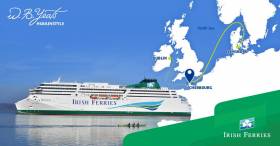Displaying items by tag: Debut to France
W.B. Yeats Makes Debut to France, However Routes from Rosslare Unlikely to Operate in 2019
#ferry - Since Afloat's tracking on Sunday of German built cruiseferry W.B. Yeats in Danish waters, the brand new ship crossed the North Sea to France, completing a first leg of a delivery voyage to Ireland, writes Jehan Ashmore.
The €144m cruiseferry ordered by Irish Continental Group (ICG) for division, Irish Ferries, docked in Cherbourg earlier today for berthing trials. The call was in advance of the 1,800 passenger/1,200 vehicle cruiseferry entering service on the Dublin-Cherbourg route in mid-March 2019.
In a facebook posting from Irish Ferries late this afternoon, they informed customers that they are unlikely to operate a service between Rosslare and France in 2019. The operator added that they will continue to keep this situation under review and stated that their new W.B. Yeats ship will operate from Dublin to Cherbourg up to 4 days per week.
Irish Ferries also commented that "a majority of our customers have a clear preference for the more central location and easy access of Dublin".
Prior to the debut to France of W.B. Yeats today, the Cypriot flagged 54,000 gross tonnage newbuild also made a transit through the Strait of Dover. This is the world's busiest shipping lane, where up to 400 ships daily transit the narrow strait between the UK and France.
While W.B. Yeats was in these busy waters, ferries were routinely shuttling between Dover and Calais, served by rivals, P&O and DFDS. The latter operator is a giant Danish owned shipping group that briefly entered the Irish Sea ferry market, though ro-ro operations now are concentrated on the English Channel. In addition to services on the North Sea where an extensive freight network serves Scandinavia and beyond in which Afloat will have more to report.
As for passengers operations on the Dublin-Cherbourg route, customers can look forward to the service operated by the luxury ferry that was many months overdue of this summer's intended introduction. Delays of the 194m newbuild during the crucial high-season, were caused by contractors in supplying the shipbuilder, Flensburger Schiffbau-Gesellschaft (FSG) located in Flensburg. This led to cancellations resulting in a major disruption effecting up to 19,000 passengers.
The year-round operated Dublin-Cherbourg route, was first launched by Irish Ferries back in 2014, initially served by ropax Epsilon based on a economy no-frills service. From autumn this year, the more-freight orientated ferry was joined by cruiseferry Oscar Wilde, having ended the more established seasonal Rosslare based routes to France. The Cherbourg route began in 1978, albeit by predecessor, Irish Continental Line (ICL) whereas the route to Roscoff was added by Irish Ferries in 1995.
The deployment in recent months of the 31,000 tonnes Oscar Wilde to Dublin (incl. to Holyhead) has provided an increased choice of service and sailing capacity, while W.B. Yeats remains to enter service in early 2019. Added to this will be the backdrop of whatever Brexit scenario arises, when the new cruiseferry is launched on the direct route linking Ireland and mainland Europe.
In the meantime, W.B. Yeats, today carried out berthing trials firstly at the linkspan on the Quai de Normandie. Following this, the cruiseferry which has 440 cabins, including luxury suites with private balcony sea views and a dedicated butler service, docked at the adjacent Quai de la France.
At this quay is the former Trans Atlantic Ocean liner terminal (Gare Maritime Transatlantique) that still stands and is located in the centre of the port. This grand historic building is occupied by the maritime museum, La Cité de la Mer.
It will be just a few more days in welcoming W.B. Yeats arrival to Dublin Port according to Irish Ferries. The completion of the maiden delivery voyage, will represent the largest ever cruiseferry for the operator in terms of gross tonnage, compared to the current flagship Ulysses which is 50,000grt and serves on the Dublin-Holyhead route.
























































